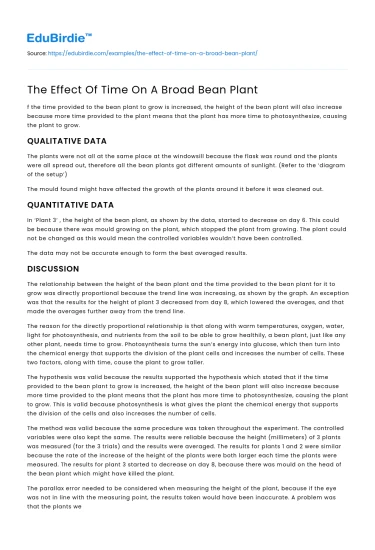f the time provided to the bean plant to grow is increased, the height of the bean plant will also increase because more time provided to the plant means that the plant has more time to photosynthesize, causing the plant to grow.
QUALITATIVE DATA
The plants were not all at the same place at the windowsill because the flask was round and the plants were all spread out, therefore all the bean plants got different amounts of sunlight. (Refer to the ‘diagram of the setup’)
Save your time!
We can take care of your essay
- Proper editing and formatting
- Free revision, title page, and bibliography
- Flexible prices and money-back guarantee
The mould found might have affected the growth of the plants around it before it was cleaned out.
QUANTITATIVE DATA
In ‘Plant 3’ , the height of the bean plant, as shown by the data, started to decrease on day 6. This could be because there was mould growing on the plant, which stopped the plant from growing. The plant could not be changed as this would mean the controlled variables wouldn’t have been controlled.
The data may not be accurate enough to form the best averaged results.
DISCUSSION
The relationship between the height of the bean plant and the time provided to the bean plant for it to grow was directly proportional because the trend line was increasing, as shown by the graph. An exception was that the results for the height of plant 3 decreased from day 8, which lowered the averages, and that made the averages further away from the trend line.
The reason for the directly proportional relationship is that along with warm temperatures, oxygen, water, light for photosynthesis, and nutrients from the soil to be able to grow healthily, a bean plant, just like any other plant, needs time to grow. Photosynthesis turns the sun’s energy into glucose, which then turn into the chemical energy that supports the division of the plant cells and increases the number of cells. These two factors, along with time, cause the plant to grow taller.
The hypothesis was valid because the results supported the hypothesis which stated that if the time provided to the bean plant to grow is increased, the height of the bean plant will also increase because more time provided to the plant means that the plant has more time to photosynthesize, causing the plant to grow. This is valid because photosynthesis is what gives the plant the chemical energy that supports the division of the cells and also increases the number of cells.
The method was valid because the same procedure was taken throughout the experiment. The controlled variables were also kept the same. The results were reliable because the height (millimeters) of 3 plants was measured (for the 3 trials) and the results were averaged. The results for plants 1 and 2 were similar because the rate of the increase of the height of the plants were both larger each time the plants were measured. The results for plant 3 started to decrease on day 8, because there was mould on the head of the bean plant which might have killed the plant.
The parallax error needed to be considered when measuring the height of the plant, because if the eye was not in line with the measuring point, the results taken would have been inaccurate. A problem was that the plants were not all at the same place at the windowsill because the flask was round and the plants were all spread out, therefore all the bean plants got different amounts of sunlight (refer to the ‘diagram of the setup’) . The mould found on one of the bean plants might have affected the growth of the other bean plants around it before it was cleaned out, because mould spreads easily in moist conditions.
Possible improvements to the method could be to plant the bean seeds in separate flasks. This would mean that each bean plant will have more space for its roots to grow down and to support the bean plant’s stem while it’s growing taller. This would also mean that if mould, for example, grew in one of the flasks, the other bean plants would not be affected by it as they are in separate flasks.
A possible extension to the method could be to plant the bean seeds in soil, in contrast to the wet paper towels, to test how the bean plant grow in different planting conditions.
CONCLUSION
The experiment showed that as the time provided to the bean plant to grow increased, the height of the bean plant also increased because photosynthesis turns the sun’s energy into glucose, which then turn into the chemical energy that supports the division of the plant cells and increases the number of cells. These two factors, along with time, warm temperatures, oxygen, water, light, and nutrients from the soil, cause the plant to grow taller.
This supports the hypothesis because as the time provided to the bean plant to grow is increased, the height of the bean plant also increased because more time provided to the plant means that the plant has more time to photosynthesize, causing the plant to grow. This is valid because photosynthesis is what gives the plant the chemical energy that supports the division of the cells and also increases the number of cells.






 Stuck on your essay?
Stuck on your essay?

